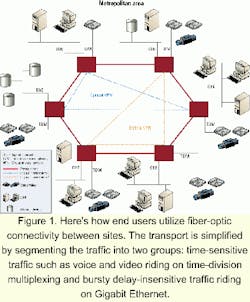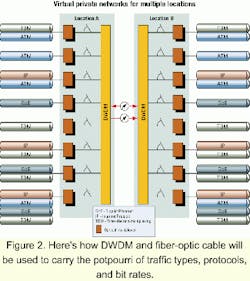GbE + TDM + dark fiber = metro broadband potpourri
The way to high-bandwidth service provision in the metro is becoming clearer.
BY DAVID G. RUSIN,
American Fiber Systems Inc.
There is no doubt that the world is quickly moving toward an all-optical communications network, in which eventually every telephone conversation, telemedicine application, Internet session, digital music file, interactive video frame, and financial transaction will originate and terminate across optical equipment and travel across optical fiber. Why? Because the structural physics of fiber is better suited to carry a high capacity of information than any other medium known to mankind.
Millions of words have been churned out and hundreds of conference sessions held about the simple and incontrovertible fact that today's copper infrastructure-as solid and reliable as it is for voice-only transmission-will soon be superseded by the need for a more capacious, flexible, and ultimately simpler and more cost-effective broadband infrastructure. Cop per-based access technologies-ISDN, DSL, and cable modems-will provide only temporary last-mile relief for an increasingly impatient universe of users. Wireless, with its high dependency on silicon wafering, is not even close to providing sufficient capacity or speed to meet the last-mile needs of users. With the worldwide demand for broadband communications doubling every six months to a year, the optical network of the future is only years, not decades, away.
Obviously, an end-to-end optical network is contingent on an end-to-end fiber infrastructure, and communications companies are moving quickly in that direction. The U.S. long-haul network is almost completely fiber, and fiber-to-the-pedestal and fiber- to-the-home are increasingly common. However, an even bigger development is taking place. Finally, mid-sized metropolitan areas are about to receive the benefits of dark fiber broadband rings. These rings will enable large groups of carriers and service providers to obtain infinite broadband capacity without relying on incumbent local-exchange carriers or using precious capital to build their own multimillion-dollar networks.Metropolitan networks represent the most complex components of the communications network mix. Unlike long-haul networks, which merely transport traffic, metro networks sit where the action is-they are where the switches and routers reside and where most phone calls and data packets originate and terminate. The fiber being installed in metro networks is of premium quality and capable of handling the full spectrum of communications needs across its entire bandwidth. This full-spectrum characteristic of metropolitan fiber is key to the success of the all-optical network. A full-spectrum fiber not only offers lower equipment and maintenance costs, but also by its very nature limits the amount of fiber needed to offer an array of broadband applications.
The metropolitan network is commonly divided into three distinct entities:
- Feeder network. Carries traffic from the customer to the serving wire center or other aggregation point-commonly called the "last mile."
- Access network. Extends from central offices or hub locations to regional switches and data sites.
- Regional network. Runs through not only the central business district of the city, but also the outlying region, which is growing as businesses sprawl from congested city centers to the suburbs and beyond.
The movement toward all-optical networks is taking place in all three of these network components and is being led by business applications, largely due to the power and promise of Gigabit Ethernet. Within a few years, the metro network will be fiber end-to-end, and optical virtual private networks (VPNs), created using Gigabit Ethernet, will be commonplace (see Figure 1).
Since springing onto the scene less than five years ago, Gigabit Ethernet (GbE) has become the darling of data communications. Invented at Xerox Corp. in the early 1970s, its predecessor, Ethernet, already represents the dominant networking protocol. GbE builds on top of the Ethernet protocol but increases bit rate by a factor of 10 over Fast Ethernet to 1,000 Mbits/sec (or 1 Gbit/sec). This protocol, which was standardized in 1998, promises to be a dominant force in high-speed LAN backbones and server connectivity.
GbE utilizes the same carrier sense multiple access with collision detection (CSMA/CD) protocol for flow control, the same frame format, and the same frame size as its predecessors. For the lay person, that means existing network investment can be extended to gigabit speeds at reasonable initial cost without the need to re-educate support staff and users and without the need to purchase additional protocol stacks or middleware. The bottom line is that GbE presents a very favorable low cost of ownership. The reasons for this are fairly simple and straightforward:
- Ethernet is familiar-the most established and data-centric access method in the world, capable of easy plug-and-play with Internet Protocol (IP) technology and compatible with emerging SONET/ SDH architectures. More than 300 million Ethernet ports are currently installed, representing 97% of available network connections. The remaining network connections are a combination of Token Ring, FDDI, ATM, and other protocols.
- The transition from Ethernet to Gigabit Ethernet is simple, and the upgrade cost is low. GbE uses the same frame format as traditional Ethernet, reducing the time and cost of developing equipment. IP professionals who are familiar with Ethernet and Fast Ethernet will have no trouble implementing Gigabit Ethernet.
- All popular operating systems and applications found in today's client/ server systems and personal computers are Ethernet-compatible, as are upper-layer protocol stacks such as Transmission Control Protocol/Internet Protocol (TCP/IP), IPX, NetBEUI, and even ancient DECnet.
- Training needs for GbE are minimal.
- While it is currently enterprise-centered, GbE will soon migrate to the edge of the network to take advantage of broadband speeds and petabit storage, as additional broadband capacity becomes available through dark fiber metropolitan networks.
- GbE offers a 100-to-1 cost advantage over traditional SONET/SDH, ATM, and frame-relay alternatives. The equipment required to deliver 600 Mbits/sec across an OC-12 link using WDM is about $125,000, plus engineering costs. A GbE port can produce the same results for about $800.
And most important, as bandwidth demands increase, Gigabit Ethernet is the most appropriate and best-positioned technology to manage the conglomeration of data that will flow through tomorrow's networks.
Among the most common current applications for GbE is the creation of VPNs for enterprises with multiple locations. DWDM equipment carrying GbE makes it simple to interconnect distant buildings in a VPN that looks very much like a LAN (see Figure 2). The new technology, which uses lambdas as the connection pathways be tween locations, provides the flexibility, simplicity, and ease of use that make it easy to unite one company's disparate facilities in a powerful but simple private network.
Notice the emphasis so far is on data. Voice is another issue, and it's important to remember that for the near future, voice will still be the cash cow of communications. As networks evolve, all possible steps must be taken to preserve and enhance the quality of voice transmission; lapses in voice quality will not be tolerated.The most efficient optical networks of the future will carry a number of protocols and transmission technologies, each of which will do what it does best and all of which will run very efficiently across full-spectrum metropolitan fiber.
While Gigabit Ethernet will emerge as the winner in the data category, it is not necessarily the best protocol for voice. At this time, our nominee for the most efficient and cost-effective voice protocol will be time-division multiplexing (TDM).
TDM offers a number of important advantages for voice transmission:
- Like Ethernet, it is a familiar technology, so training needs are minimized.
- The equipment is currently in place to efficiently carry both TDM and GbE.
- New optical multiplexers use the existing SONET frame structure to carry TDM and manipulate that frame structure to carry GbE
- Provisioning TDM is a non-issue-users are comfortable with the technology.
- TDM interfaces are available, inexpensive, and functional.
The primary benefit of building metropolitan networks that carry both TDM-based voice and GbE-based data over fiber is simplicity and, consequently, economy. As a connection-oriented Layer 2 protocol, ATM comes with built-in provisioning problems. Any changes require the establishment of either permanent virtual circuits (PVCs) or switched virtual circuits (SVCs) to establish logical connections between ATM devices; these circuits carry an overhead burden of 20-25%, which drains substantial efficiency. Even the Level 3 IP connectionless protocol is extremely complex and thus overly expensive. These technologies also require the care and feeding of expensive teams of IP experts to provision, configure, and maintain complicated protocols and finicky equipment. TDM avoids the cracking and routing of packets, the cumbersome exchanging of routing tables, and the unnecessary financial burden of skilled personnel.
New optical equipment allows fiber bandwidth to be shared by both protocols efficiently. The portion of the pipe used for data can be oversubscribed without affecting the quality of the voice traffic. Equipment may be configured to carry all data, all voice, or any combination of the two. The bandwidth is flexible and easy to manipulate. With WDM, fiber can be used even more efficiently, with more information packed onto every strand.
The combination of GbE, TDM, and dark fiber is an ideal solution for the demands that network planners soon will be facing.
This combination provides the perfect infrastructure for all types of traffic-IP voice, video, and streaming video (and audio) as well as next-generation networks. As we approach the network of the near future, our emphasis should be on simplicity, functionality, and expense.
Of course, the success of this new metro-network strategy is contingent on the availability of dark fiber networks in redundant ring configurations, which will provide the essential backbone and unlimited bandwidth to carry voice traffic over TDM and data over Gigabit Ethernet.
Fortunately, the fiber being installed in metro networks today will easily accommodate whatever technology service providers decide to implement in the future.
David G. Rusin is founder, president, and CEO of American Fiber Systems Inc. (Rochester, NY). He can be reached at [email protected].


